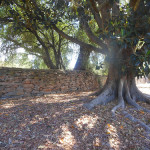We run our website the way we wished the whole internet worked: we provide high quality original content with no ads. We are funded solely by your direct support. Please consider supporting this project.

The Warfare We Have Inherited
Image by Chris Sardegna
Jesus’ miracles over nature, as well as his healings, exorcisms and especially his resurrection, were definite acts of war that accomplished and demonstrated his victory over Satan. These acts routed demonic forces and thereby established the kingdom of God in people’s lives and in nature. But their primary significance was eschatological. People are still obviously being demonized; all people still get sick and die; storms still rage and destroy lives; famines are yet prevalent and starve thousands daily. But Jesus’ ministry, and especially his death and resurrection, in principle tied up “the strong man” and established the kingdom of God and the restoration of a new humanity in the midst of this war zone. In doing this, Jesus set in motion forces that will eventually overthrow the whole of this already fatally damaged Satanic assault upon God’s earth and upon humanity.
Gustaf Wingren expresses this “already/not yet” dynamic well when he argues that with Christ’s resurrection
The war of the Lord is finished and the great blow is struck. Never again can Satan tempt Christ, as in the desert. Jesus is now Lord, Conqueror. But a war is not finished, a conflict does not cease with the striking of the decisive blow. The enemy remains with the scattered remnants of his army, and in pockets here and there a strong resistance may continue. That is the position of the church. (The Living Word: A Theological Study of Preaching and the Church)
Jesus’ miraculous ministry, therefore, was not simply symbolic of the eschaton–in principle it achieved the eschaton. He in principle won the war, struck the decisive deathblow, vanquished Satan, restored humanity, established the kingdom; yet some battles must still be fought before this ultimate victory is fully manifested. Hence Jesus did not just carry out his warfare ministry; he commissioned, equipped and empowered his disciples, and the whole of the later church, to do the same. He set in motion the creation of a new humanity, one that again exercises dominion over the earth, by giving us his power and authority to proclaim and demonstrate the kingdom just as he did (e.g., 2 Cor 5:17-21; Mt 16:15-19; Lk 19:17-20; cf. Jn 14:12; 20:21).
Jesus thus gives to all who will in faith receive it his authority to break down the gates of hell and take back for the Father what the enemy has stolen, just as he himself has done (Mt 16:18). Now that the strong man has been bound, it is a task we can and must successfully carry out. In doing all this, we the church are further expanding the kingdom of God against the kingdom of Satan and laying the basis for the Lord’s return, when the full manifestation of Christ’s victory, and of Satan’s defeat, will occur.
God at War, pp. 213-214
Category: General
Tags: Already Not Yet, Eschatology, Jesus, Kingdom, Satan, Spiritual Warfare, Warfare Worldview
Topics: Spiritual Warfare, Cosmic Conflict
Related Reading

Book Review: Understanding Spiritual Warfare: Four Views
I just got the pre-release copy of Understanding Spiritual Warfare: Four Views, edited by my friends James Beilby and Paul Eddy (IVP, 2012). The introduction alone is worth the price of the book! It is the clearest, most comprehensive, yet most succinct overview of the concept of spiritual warfare throughout church history that I’ve ever…

The Incarnation: Paradox or Contradiction?
We’re in the process of flushing out the theology of the ReKnew Manifesto, and we’ve come to the point where we should address the Incarnation. This is the classical Christian doctrine that Jesus was fully God and fully human. Today I’ll simply argue for the logical coherence of this doctrine, viz. it does not involve…

Why Did Jesus Curse the Fig Tree?
One of the strangest episodes recorded in the Gospels is Jesus cursing a fig tree because he was hungry and it didn’t have any figs (Mk 11:12-14; Mt 21:18-19). It’s the only destructive miracle found in the New Testament. What’s particularly puzzling is that Mark tells us the reason the fig tree had no figs…

Sermon: God Needs Prayer
In this sermon clip, Greg Boyd discusses some of the challenges we face when praying. The full sermon wrestles with questions like: If God is all-powerful, does he need our prayers to change this world? And is it even worth praying if we can’t see the results? Greg addresses these questions as he begins a…

What the Cross Tells Us About God
Whether we’re talking about our relationship with God or with other people, the quality of the relationship can never go beyond the level of trust the relating parties have in each other’s character. We cannot be rightly related to God, therefore, except insofar as we embrace a trustworthy picture of him. To the extent that…

Why a “Christocentric” View of God is Inadequate: God’s Self-Portrait, Part 5
I’m currently working through a series of blogs that will flesh out the theology of the ReKnew Manifesto, and I’m starting with our picture of God, since it is the foundation of everything else. So far I’ve established that Jesus is the one true portrait of God (See: Part 1, Part 2, Part 3, Part 4).…
